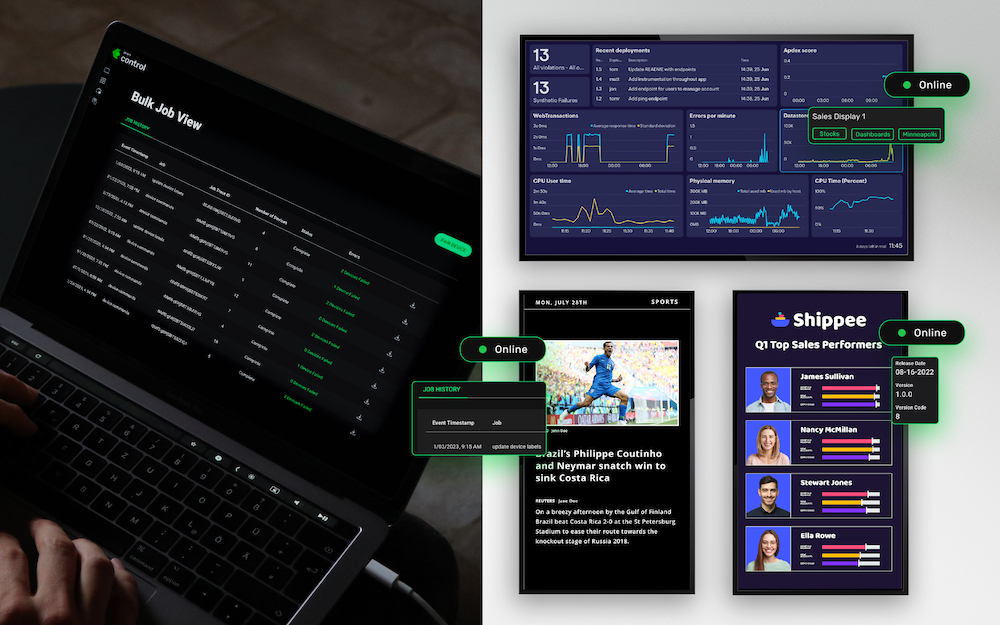Abraham Lincoln once said, “Give me 6 hours to chop down a tree and I will spend the first 4 sharpening the ax.”
Modern digital signage can do some pretty amazing things for businesses these days—from advertising to real-time dashboards to interactive content. But making sure you invest time on the front end to create a solid content strategy truly makes the magic (and return on investment!) happen.
We work with digital signage users (across various industries) to help set their goals and work towards reaching them. That work usually begins with the company’s digital signage content strategy plan. Here’s an insider’s peek at how we do it…
1. Conduct A Post-Mortem Meeting
Before the planning gets underway, we recommend looking back at how your team used any signage solution in the past year. It might have been digital, but it could even have been a traditional bulletin board or a printed poster. Everything counts!
Now consider the following questions:
- What were the original goals for your signage? Did you meet those goals?
- How often did you intend to update content? What was the reality?
- Who contributes to your signage content? Are they the right people?
- Did the location of your displays help meet your communication goals?
- Are there other audiences who should be seeing your signage?
- Do your teams use data dashboards and want to share more broadly?
Document your responses. These answers will inform your next steps.
2. Set SMART Goals
Once you’ve assessed your organization’s previous signage use, it’s time to set some new goals. A clearly stated SMART goal (Specific, Measurable, Attainable, Realistic, and Time-Bound) will help your team understand the value of the signage solution you’re seeking, and will ultimately lead to better outcomes.
Engaging the full team to map out your new goals will help capture each stakeholder’s objective.
Still trying to figure out where to start?
Here are a few common goals we’ve heard teams consider when they’re planning their digital signage content strategy:
- Increase team engagement by fostering awareness of business objectives and affinity toward the organization.
- Monetize advertising space in high-traffic areas.
- Leverage gamification to encourage specific behaviors.
- Enhance workplace safety and minimize incidents.
- Boost social media engagement and expand reach.
- Embrace eco-friendly practices and reduce printed materials.
If this all seems like a lot, don’t worry. Start by setting 1-2 goals for your digital signage.

Starting small will get the ball rolling towards that first win. Once you’ve celebrated that initial success, you can work on additional improvements.
3. Plot It Out
By now, you’ve assessed how you used digital signage in the past—and identified your short-list goals.
Now it’s time to work through the types of content you’ll need to keep your screens engaging and fresh.
We’ve created a content calendar that you can use, with a map for the coming weeks and months with recommendations on maximizing your digital signage solution.
Download our easy template to unlock your potential right away. Once you’ve got your content planning tool, you can map out your digital signage content strategy more effectively.
Although some content cannot be planned, most display content can be programmed in advance.
A Few Content Ideas For Your Calendar:
- “Evergreen” pieces that work anytime, including company goals, corporate videos, or safety messages.
- Timely communications such as upcoming company events, holidays, birthdays, and anniversaries.
- National observance days that indicate building hour changes, or just-for-fun holidays (like International Talk Like a Pirate Day 🏴☠️🦜).
- Real-time data visualizations using Skykit’s Dashboard Connections
- Feeds like RSS, weather, news, finance, social media.
4. Measure It
Once you’ve spent time planning your digital signage content strategy (goals, content, cadence), it’s essential to identify how you will measure your success. How will you know if you’ve met your goals?
First off, understand the baseline of how your digital signage content is doing today. This will make it easier to measure the impact of specific campaigns or new scheduled content, and how those pieces are driving improvement.
After celebrating initial victories, you can continue to make additional enhancements supported by metrics from:
- Surveys or eNPS
- Organizational reviews (i.e., QBRs)
- Social media engagement analytics
- Internal event attendance and questionnaires
- Workplace incidents
- Usage of dedicated URLs, promotion codes, or QR codes
- Qualitative Feedback
5. Apply + Adjust

As you analyze the data over time, take the learnings from each category and keep adjusting your strategy accordingly. Consider using the questions from Step 1 (above) each year.
For example, suppose your organization modified the use of a meeting space during the year.
When you review the question: “Did the location of my displays help meet our communication goals?”—take a strategic look at that new meeting space.
You might conclude you need to budget for another display or plan for a new piece of content.
These types of reflections allow you to flex your organization’s digital signage content strategy appropriately.
We always encourage our Skykit customers to experiment with new use cases and content types.
The greatness of digital signage lies in its adaptability. And, there are endless ways to engage audiences through iterative improvements to your content. The Sky’s The Limit!
Improve Your Digital Signage Content Strategy With Skykit
Let’s go back to those wise words about taking the time to sharpen your tools before diving into a high-impact project.
This timeless wisdom serves as a powerful reminder that in every endeavor, preparation is the key to success.
Skykit is here to help you do just that. Contact us for your digital signage content strategy questions.
Our Customer Success team holds weekly small group training sessions—let us know if you’d like to join! We’re always happy to strategize about your particular business goals.




